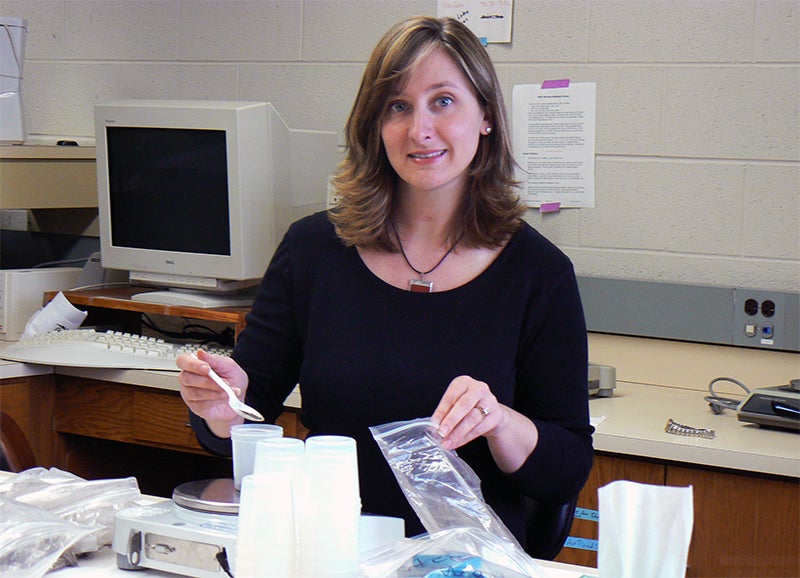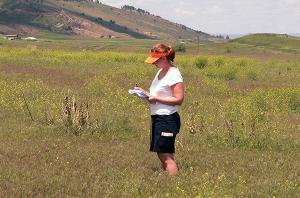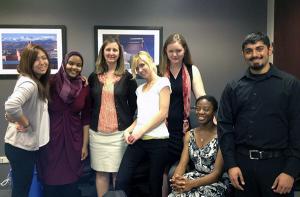Five questions for Laurel Hartley
The daughter of two teachers, young Laurel Hartley looked forward to annual summer trips with her parents to national parks across the country.
“I spent so much time outdoors that I started to think a lot about biodiversity and ecology,” Hartley said. “I never considered that it could be a career until college when I took my first ecology course. I was an English major, but I took Biology for majors instead of Biology for non-majors because I wanted to take a class with my friends. I found I really liked it. As a junior in college, I did a National Science Foundation Research Experience for Undergraduates experience. I found I really liked doing research. That led me to an internship doing research at the Natural History Museum in London and then to graduate school at Colorado State University. I didn’t chart a specific career path, I just applied for every interesting opportunity.”
Those opportunities led her to CU Denver, where she is an associate professor in the Department of Integrative Biology, and co-director of the STEM Learning Assistants Program. In 2020, she was one of two faculty members across the system awarded the title of CU President’s Teaching Scholar.
“I think it is amazing that the University of Colorado has this community of President’s Teaching Scholars,” Hartley said. “I was excited and intimidated to apply because of how amazing the people in the group are. I wanted to be part of the group years ago because I wanted to learn from these great teachers. I finally got up the courage to apply. It is humbling to be in the group. I am excited, though, to be in the community, because it is a place where I can talk about teaching and learn from talented and thoughtful educators.”
When she isn’t busy with her career in academia, Hartley might spend an afternoon wandering through the Denver Botanic Gardens.
“I love to go to Natural History Museums and Botanic Gardens in any city I visit. I also like to spend time biking, hiking and camping with my friends and family,” she said. “I have two elementary-age children. I absolutely love being a spectator for kids’ sports because the kids have so much fun and hilarious things happen so often.”
1. You lead several workshops, including Principles and Strategies for Effective Teaching; another series is the Inclusive Pedagogy Academy. What do attendees learn in these?
Principles and Strategies for Effective Teaching is a workshop I co-teach at the CU Anschutz Medical Campus. The workshop is for graduate students and postdocs in the biomedical sciences. I have co-taught this the last few years with Mitch Handelsman and Mike Ferrara, both of whom are fantastic educators and colleagues. The workshop was first imagined by Inge Wefes as part of an NIH BEST grant to CU Anschutz. The grant has ended but we keep offering the workshop.
We frame the workshop using backward design. In backward design, you start by first writing clear objectives. After you know what you want students to learn and be able to do, you carefully design assessments that can provide information about student learning, and then you design learning activities that will help students both meet the objectives and do well on the assessments. Although it seems pretty obvious that backward design is a good way to design a course or a lesson, it isn't how college teachers typically do it. We typically start with a text or sets of activities.
The Inclusive Pedagogy Academy (IPA) is a series of workshops for faculty to deeply discuss what it means to teach inclusively. Until recently, many of the efforts to address differences in retention between all students and minoritized students have been built on a “deficit model,” which asserts that some students are “unprepared” and need to be “fixed” to survive in higher education. The IPA takes the view that learning environments should be examined and changed to be more inclusive and equitable places.
In the IPA, we talk about how societal, educational and institutional systems and structures promote or prevent equitable outcomes for all students. We also talk about how students’ social identities and experiences shape the ways that they perceive and participate in our classes. Finally, we discuss specific inclusive instructional policies and practices that promote equity and reduce barriers to success in our classes.
I worked on the development team for the IPA. The IPA creation and delivery were funded by a grant from the Howard Hughes Medical Institute.
2. You research science education for grades six through 12 and at the college undergraduate level. Are there effective approaches that work at both levels?
In my research, I think a lot about conceptual understanding of biological phenomena and how conceptual understanding is developed over time. I think there are definitely effective approaches that work at both the K-12 and undergraduate levels.
One of the most effective approaches, in my view, is to teach students to use principled reasoning in place of memorizing. Biological phenomena are more easily understood when we learn to think about phenomena in terms of the principles and laws that underlie them. For example, it is easier to understand metabolism when you apply the Laws of Thermodynamics to trace matter and energy from food through the body systems and into cells.
3. You have said, “The pathway to student success in my classes should be well lit,” and that “Teaching and mentoring well is really, really hard.” Can you elaborate on those thoughts?
I believe that students should have a clear understanding of the objectives in my class and they should even help determine those objectives. I also think students should have a clear idea of the actions they can take in order to meet those objectives. I believe there should be ample opportunities for students to seek clarification and get feedback. I want students to know that I genuinely want all of them to succeed and that I believe they can. If a student didn’t do well in my course because they didn’t know what they were supposed to do in order to succeed and they didn’t feel they could talk with me, I would feel that I failed in terms of providing an equitable, inclusive and rigorous learning environment.
I think it is challenging to provide enough meaningful opportunities for truly deep learning. I find this hard because, to create good activities for students, you have to know a lot about how a concept is best learned. This takes experience and diving into the literature about learning of specific concepts. You also have to know your students and care about what their personal goals are, how they interact with each other, and what things they find engaging.
Sometimes with big classes, it is hard to spend enough time with every student. This is one of the reasons I love the Learning Assistant Program. LAs help me know my students better. I also think it is challenging to give really good actionable and timely feedback to students about their learning. This is because you have to have good diagnostic formative assessments and you have to have time to respond to student work. I find I never quite have enough time. Learning Assistants are also invaluable for this, especially in large classes.
4. How did you respond to the pandemic-driven need to teach remotely?
I tried to respond first from a perspective of care for students’ well-being.
Most students at CU Denver work. Many of my students worked in essential jobs and/or had children who were suddenly home instead of at school or daycare. I also had students who lived alone and missed the social interaction that attending classes at CU Denver gave them. I had some students who unfortunately had firsthand experience with COVID personally or in their household.
I modified my course so that students could do lectures and activities with me and my Learning Assistants during class time or do things independently using recorded lectures with embedded activities. I also was very flexible about due dates. I tried to keep people motivated and keep expectations really clear by sending an email every Sunday night that had a checklist for the course. The list included actions broken into 20-minute chunks, because I figured some students would need to work school into their schedules, which had likely changed. The list for the current week always had “catching up on unfinished work from previous weeks” as the first item. That was to help students know that it was OK to get behind and they could catch up.
I also relied heavily on Learning Assistants to help facilitate breakout groups, help students catch up if they got behind, and to be someone to talk to about the class or resources on campus.
5. What’s next for your teaching and research?
One of my latest projects has been to develop a Course-based Undergraduate Research Experience (CURE) about Urban Ecology. My graduate student, Sarah St. Onge, developed an initial six-week curriculum that all students in the introductory biology lab for majors do. The students help set up cameras across the Denver area to capture images of urban wildlife. They identify the animals in the thousands of photos and we send the data to the Urban Wildlife Information Network. The students also do their own mini-investigations of the data.
One of my goals is to study the effects of the CURE on students’ learning and their sense of belonging in science. I also want to research ways to train Teaching Assistants to facilitate CUREs. Finally, I am working with UWIN partners to answer ecological questions about urban wildlife. Although most of my current research is in Science Education, I can’t seem to get completely away from doing research in Ecology.






